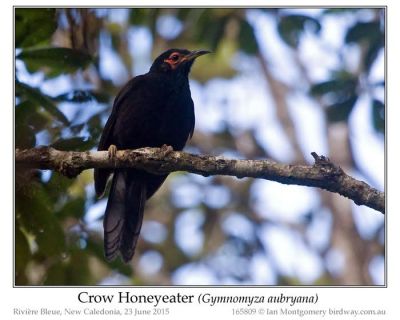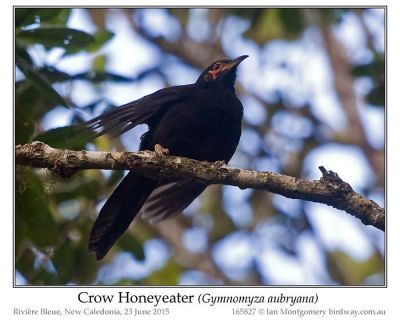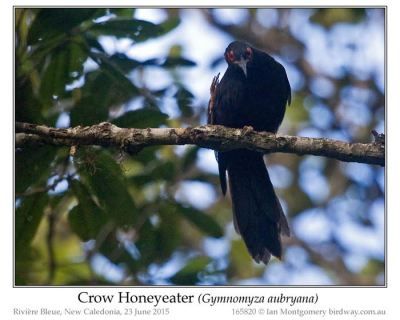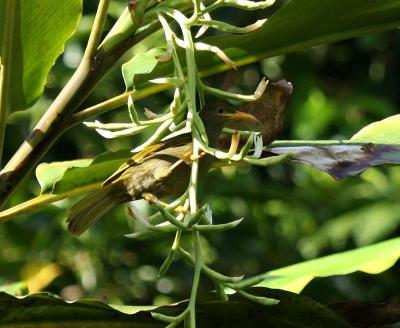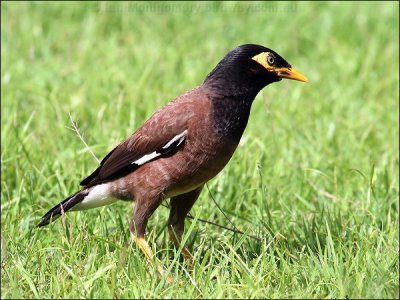I’m currently working my way through the Honeyeater galleries on the website and on Saturday I’m giving a talk on the birds of New Caledonia to BirdLife Townsville, so here is New Caledonian endemic the Barred Honeyeater. it is confined the main island of Grande Terre, where it is reasonably common in woodland areas, particular in hilly country, e.g. Mont Koghi just outside Noumea.
It seemed to like perching high up in trees, like this one at Riviere Bleue, and at the time we had bigger distractions at hand (such as the Kagu) so we left it to its own devices.
On our second visit to Mont Koghi (in search of the Horned Parakeet) we came across this one perched more obligingly at eye level in some flowering ginger. While we were photographing it, a member of the staff at the nearby inn, came galloping along to tell us that a Horned Parakeet had arrived, and the poor honeyeater was abandoned unceremoniously.
From its shape and general appearance it’s clearly a Honeyeater, but the wavy barred plumage is unlike any Australian Honeyeater and gives it its specific name undulata. Not surprisingly, it has no close relatives in Australia, though it was plonked in the same genus as the New Holland and White-cheeked Honeyeaters (Phylidonyris) until someone decided to look at its genes a bit more closely and removed it and its only close relative the Vanuatu Honeyeater (G. notabilis) to their own genus.
New Caledonia has some strikingly unusual birds – which is why we were there in the first place – but this familiar but different theme was much more often the case with a broad spectrum from very similar (same species but usually a different race) through somewhat different (common genus, different species) and very different (separate genera) to the Kagu which is in a family of its own and an in order with no other Australasian representatives. I found this very interesting and this is why the theme of my talk at 2:00pm on Saturday afternoon is “New Caledonian Birds: from strangely familiar to very strange”. You can find out about the activities of Birdlife Townsville here http://www.birdlifetownsville.org.au/2016_Calendar.html and details of the location here http://www.birdlifetownsville.org.au/Activities.html.
Work on converting the website to make it ‘mobile friendly’ continues and I’m in the middle of the Honeyeaters With photos of 76 species – and therefore 76 galleries – this is easily the largest family in the website – the ducks and their relatives come second with 64 species. So, I regard it as something of a watershed and look forward to having the Honeyeaters behind me and tell myself that it will all be downhill from then on!
If you’re a local or in the Townsville area, I hope to see you on Saturday.
Ian
**************************************************
Ian Montgomery, Birdway Pty Ltd,
454 Forestry Road, Bluewater, Qld 4818
Tel 0411 602 737 ian@birdway.com.au
Bird Photos http://www.birdway.com.au/
Recorder Society http://www.nqrs.org.au
Lee’s Addition:
The rainbow shall be in the cloud, and I will look on it to remember the everlasting covenant between God and every living creature of all flesh that is on the earth.” (Genesis 9:16 NKJV)
Beautiful rainbow photo and the of course the Barred Honeyeater is pretty. I noticed that in each photo the bird has his eye on Ian. Thanks, Ian, for sharing another of your adventures into the world of avian wonders.
*
Ian’s Bird of the Week articles
*























